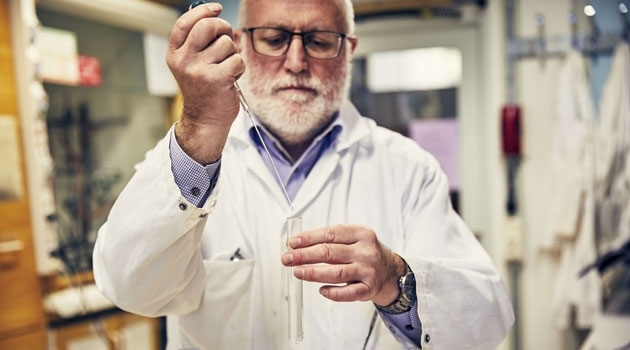He analysed Alfred Nobel’s chemicals
In collaboration with the Swedish National Heritage Board and Uppsala University, the Nobel Prize Museum has determined the contents of 43 old bottles and tins from Alfred Nobel’s laboratory. “A surprisingly well-preserved collection of chemicals,” according to Professor Adolf Gogoll of the Department of Chemistry – BMC.
It was Professor Gogoll himself who performed the chemical analyses after the bottles and tins were shipped to Uppsala from the Nobel Museum in Karlskoga. There were large tins containing inorganic salts and oxides, as well as bottles containing various liquids.
“The most surprising aspect was that the contents were so well preserved. Of all of these organic substances, only a few showed signs of decay,” he says.
When exposed to air and daylight, the chemicals can either oxidise (react with oxygen) or polymerise; however, Adolf Gogoll confirms that this was not the case.
“Many of them appeared to be completely pure. If someone had told me they had bought them yesterday from our usual chemical supplier, I would not have had the slightest suspicion about it.”
Difficult to open
It was however apparent that they come from another era. Some of the bottles were unlabelled and some had damaged labels. There were some notations in Italian or archaic names used. Having sat untouched for so long, several of the bottles were difficult to open.
“In such cases the substance has generally polymerised and disintegrated, in which case it becomes like glue between the bottleneck and the stopper. Most had cork stoppers that had become hard and brittle over time. We had to cautiously attempt to dig them out, so that the cork didn’t crumble.”
Having succeeded for the most part, Professor Gogoll received permission from the Nobel Museum to try heating the remaining bottlenecks with a heat gun to expand them. Three bottles broke during the process and were replaced with new ones.
“Tensions arise in the glass as old glass is not as uniform as modern industrially manufactured glass,” he explains.
Historical interest
Having been interested in the history of chemistry for some time, when the department moved to Uppsala Biomedical Centre (BMC) from the old Kemikum building on the English Park Campus in 2002, Professor Gogoll contributed to creating a small exhibition of old objects, flasks and other laboratory glassware on the staircase. A professor emeritus helped with the work as did a doctoral student who went on to work for the Swedish National Heritage Board.
“When the need arose to determine the contents of Nobel’s old bottles, she thought of me and that’s how I came to be given the task.”
He first asked head of department Helena Danielson if that was something he could do during working hours.
“She was immediately enthusiastic and was happy to pay for it. Had I not been interested in old artefacts, I would not have taken on the task, as it involves a good deal of work.”
Time-consuming chemical analyses
Professor Gogoll estimates that he has spent between 20 minutes and an hour on each bottle, carefully pouring out a small amount of the liquid in order to perform chemical analyses. Colleague Jean Pettersson was involved in determining the content of the inorganic salts using atomic absorption spectrometry.
“He used an instrument that only he can use and was just about to retire. So, that was a stroke of luck,” says Adolf Gogoll.
Annica Hulth
Facts: Alfred Nobels chemicals
- At the time of his death in 1896, Alfred Nobel had laboratories in San Remo, Paris and at Björkborn Manor just outside Karlskoga. Since the mid-1980s, some 40 bottles have been on display in a reconstruction of Alfred Nobel’s laboratory in the then newly opened Nobel Museum in Karlskoga.
- In spring 2020, the bottles were shipped to Uppsala University for analysis.
- Analysis revealed heavy metals such as lead and chromium. Some of the bottles contained substances used in the manufacture of dynamite, while others contained mixtures and possible traces of chemical reactions that Alfred Noble or his colleagues were working on.

